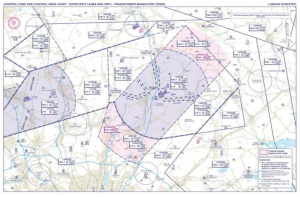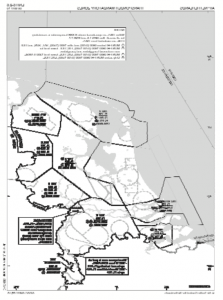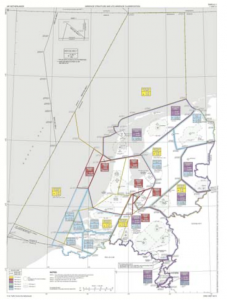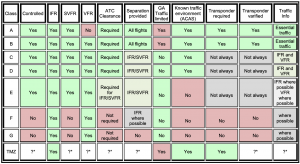51ST ANNUAL CONFERENCE, Kathmandu, Nepal, 12-16 March 2012WP No. 90Study Transponder Mandatory ZonesPresented by TOC |
Summary
Transponder Mandatory Zones (TMZ), defined areas in which the carriage of an operational transponder is required, have been implemented in several states with the intention to improve safety. This working paper explains the concept of a TMZ, elaborates on the benefits and disadvantages of a TMZ and describes what needs to be considered to implement a TMZ.
This working paper is recommending policy on pressure-altitude reporting transponders and ATM surveillance systems.
Introduction
1.1 The Technical and Operations Committee (TOC) was tasked to investigate the concept and implementation of Transponder Mandatory Zones (TMZ).
1.2. With the intention to improve safety, SSR transponder carriage regulation has been developed in several European states. The implementation of TMZs is an outcome of these developments.
1.3. The intention of this working paper is to study the concept of a TMZ, study the benefits and disadvantages of a TMZ and to provide information on best practices if and what must be considered to implement a TMZ.
Discussion
2.1 ICAO has no standard definition of a Transponder Mandatory Zone. However, a TMZ can be considered as a volume of airspace where aircraft wishing to enter or fly within the defined area must have and operate a pressure-altitude reporting transponder.
2.1.1 The air traffic density is constantly increasing and due to specific airspace classification, controlled IFR traffic can be mixed up with uncontrolled VFR traffic. Furthermore, pilots flying under VFR sometimes infringe restricted controlled airspace. The Airborne Collision Avoidance System (ACAS) of aircraft, which receive air traffic control service, will not detect this VFR traffic without an operating transponder.
2.1.2 To minimize the risk of a midair collision between unknown/uncontrolled VFR traffic and controlled commercial air transport and military jet traffic, several states have taken measures to expand the mandatory use of transponders. Some states even have the requirement for SSR Mode-S transponders.
2.1.3 In a TMZ an operational pressure-altitude reporting transponder is mandatory for all aircraft that wish to enter or to fly within the defined area. The airspace classification of the area is not changed by the introduction of a TMZ, and the pilot’s responsibility to “see and avoid” during a flight remains unchanged.
2.1.4 CTRs situated within the lateral boundaries of a TMZ are normally not part of that TMZ. In general the airspace classification in CTRs will be A to D, where the classification in TMZs is normally E or lower. Depending on the type of traffic and the type of operation within a CTR, the appropriate authorities may require different regulations and airspace classification in regard to a surrounding TMZ. IFR routes do not need to be changed and can be situated in- or outside a TMZ.
2.1.5 Transponder implies either SSR transponder with Mode A and C, a Mode S transponder, a Mode S transponder with Extended Squitter (1090 ES) or an ADS-B transponder. A transponder is fundamental for the effectiveness of ACAS in commercial air transport and is essential for the surveillance-information of an ATS-unit. Furthermore, an ATS-unit will use surveillance-information to provide separation, flight information service and alerting service to air traffic in dedicated areas.
2.1.6 Before any pressure-altitude information can be considered reliable, the pressure-altitude read-out needs to be verified by an appropriate ATS radar unit. Without this verification of the pressure- altitude read-out, incorrect altitude information can lead to negative effects in the safe operation of ACAS.
2.2 ICAO
2.2.1 ICAO Doc 8168 Aircraft Operations, Secondary Surveillance Radar (SSR) transponder operating procedures, Chapter 1 Operation of transponders:
When an aircraft carries a serviceable transponder, the pilot shall operate the transponder at all times during flight, regardless of whether the aircraft is within or outside airspace where secondary surveillance radar (SSR) is used for ATS purposes.
When the aircraft carries serviceable Mode C equipment, the pilot shall continuously operate this mode unless otherwise directed by ATC.
2.2.2 ICAO Doc 7030 Regional Supplementary Procedures, Chapter 5 Surveillance:
All aircraft operating as IFR flights in the AFI/NAT Region shall be equipped with a pressure- altitude reporting SSR transponder.
2.2.3 ICAO Doc 4444, Chapter 8 Radar Services:
SSR systems, especially those utilizing monopulse technique or having Mode S capability, may be used alone, including in the provision of separation between aircraft, provided:
a) the carriage of SSR transponders is mandatory within the area; and
b) identification is established and maintained
2.2.4 ICAO Annex 10 Aeronautical Telecommunications, 2.1.3.3.1:
Requirements for mandatory carriage of SSR Mode S transponders shall be on the basis of regional air navigation agreements, which shall specify the airspace and the airborne implementation timescales.
2.2.5 ICAO publications on the mandatory carriage of transponders are very concise, and limited to IFR traffic in specific regions (see paragraph 2.2.1). Furthermore, ICAO does not require the mandatory carriage of transponders for VFR flights. Nevertheless, ICAO does allow states to allocate areas where the carriage of transponders is required.
2.2.6 To enable all stakeholders to adhere to the mandatory carriage of SSR transponders in, ICAO advises a transition of at least a couple of years for the airborne implementation.
2.2.7 In the USA, transponders with mode C are mandated above 10.000ft and in Class B Airspace (major terminals). Exceptions are only allowed under specific conditions.
2.2.8 In the opinion of TOC, the mandatory carriage of pressure-altitude reporting transponders should globally be extended to all IFR traffic. In specific areas (especially areas with a mix of high-density IFR- and VFR traffic) safety could increase if VFR traffic were also mandated to be equipped with transponders. It would certainly improve the operation of ACAS, even in areas where there are no ATM surveillance systems.
2.3 IFATCA Policy
2.3.1 Relevant IFATCA Policy on SSR transponders:
| ATC surveillance must have priority over the interrogation signals and that the saturation of transponders must not result in the loss of data on the ground. |
2.3.2 It is questionable if the relevant IFATCA Policy is still valid in regard to changing traffic situations and the development of new technologies. To demand priority for ATC surveillance over airborne interrogation signals seems a bit unrealistic, outdated and practically difficult to achieve. If an (outdated) ATS system cannot cope with a specific determined amount of interrogation signals and transponder output/replies, the ATS handling capacity should be reduced, or even the airspace should be classified or limited in regard to that determined amount of data.
2.3.3 It is technically almost impossible to prioritize specific (ATC surveillance) interrogation signals. For how could it be possible to technically prioritize one interrogation signal over another interrogation signal? And if this would even be possible, then what would be the consequences for aircraft systems and/or ATS surveillance systems to have this capability? These facts make the IFATCA Policy unrealistic and very hard to achieve.
2.3.4 In the opinion of TOC, IFATCA Policy should require the performance of ATC surveillance systems to be capable to process all of the data necessary to provide ATC Services safely, regardless of the volume or type. Also the capability for presentation of the amount of radar labels should be considered.
2.3.5 IFATCA Policy on airspace classification:
| Airspace classification should be appropriate for the traffic operating in the airspace, to avoid over and under classification. As traffic situations change, the classification may have to change accordingly. |
2.3.6 When traffic density increases, changing the airspace classification could also be an alternative to be considered before implementing a TMZ. Transition time could be an important factor when determining which safety measures should be taken.
2.3.7 A benefit of changing the airspace classification is that it can be realised in a short time. Controller workload will increase or reduce depending on the type of airspace classification chosen. Airspace which allows (un)controlled VFR traffic will increase controller workload, airspace that excludes VFR traffic will reduce controller workload.
A disadvantage of changing the classification is that it can limit general aviation in their operations. Furthermore it could require changes in the ATS system due to the need for changing staff and systems (with additional costs) to provide a different service.
2.3.7.1 An additional possibility would be to have airspace of which the classification can temporarily be changed, for instance by NOTAM. This could reduce the limitations to general aviation operations, and keep controller workload at an acceptable level.
2.4 IFALPA Policy
2.4.1
IFALPA Annex 6: Operating altitude reporting transponders should be required for all aircraft operating at or above 3000 ft above ground level or within 15 nm of an airport served by civil air transport.
2.5 Transponder Mandatory Zones in Europe
2.5.1 There are several TMZs implemented throughout Europe for several reasons. Here are some examples from Germany, the UK and The Netherlands.
2.5.2 TMZ Friedrichshafen, Germany:

Figure 1: TMZ Friedrichshafen
2.5.3 In Germany the number of IFR movements at an airport determines which airspace classification or if a TMZ is designated for that specific airport. This designation of airspace classification or TMZ is based on an agreement between the German Ministry of Transport, the airlines and the German GA community.
2.5.4 TMZ Stansted, UK:

Figure 2: TMZ Stansted
2.5.4.1 TMZs have been implemented in the vicinity of London Stansted, as the result of an overriding safety concern in relation to number and severity of airspace infringements.
2.5.4.2 The UK considers implementing TMZs to enable several wind farms in the Greater Welsh area of the southern North Sea. It is expected that these wind farms will produce primary clutter on the ATC radar system. This clutter could obscure primary returns from aircraft and could interfere with radar tracking resulting in erroneous radar data. This would reduce the ability to observe primary- only aircraft and the increase of the risk of not detecting conflicts, which would be prevented by implementing a TMZ.
2.5.5 TMZ The Netherlands:

Figure 3: TMZ The Netherlands

Figure 4: Airspace classification The Netherlands
2.5.5.1 The implementation of TMZs in The Netherlands was a result of a couple of mid-air collisions between military jet traffic and general aviation.
2.6 The implementation of transponders in general aviation is not always feasible due to their weight, dimension and required power supply. Also specific parts of transponders, e.g. antenna and HMI, could be difficult to install in gliders and experimental aircraft. Furthermore, operational transponders in gliders could trigger a Resolution Advisory in ACAS of other aircraft during winching.
2.7 Mandating the use of operational transponders in high-density traffic areas could result in radar clutter and overlapping of radar labels. This problem could be avoided by a technical local implementation in the system, “filtering” the ATC-screen.
2.7.1 The huge amount of SSR data, due to TMZs in high-density traffic areas, has resulted at some ANSPs in overloaded ATS systems. This overload of the system resulted in the loss of radar labels without any warning to controllers working live traffic.
2.7.2 The overload of an ATS system could imply that the system is outdated and needs to be upgraded or renewed. Bringing the ATS system up to an acceptable level will normally require a considerable time and investment. Depending on the urge of the situation, especially when safety is compromised, the appropriate authorities should take effective measures by (temporarily) changing the airspace classification or implementing a TMZ.
2.7.3 Before a TMZ or airspace classification change is implemented, an impact assessment as part of a safety case should be conducted to ensure that all aspects are addressed.
2.8 TMZ versus Airspace Classification:

* Depends on the Airspace Classification inside the TMZ.
2.8.1 The cells marked with a “?” in the last row (TMZ) in the scheme in 2.8 should be made transparent and the row should be placed over one of the airspace classifications above to show the effect of a TMZ in this specific airspace. This clearly shows that implementing a TMZ in airspace classification A and B has no influence on ATM operations. A TMZ in airspace classification C and D will result in minor changes, where implementing a TMZ in classification E, F and G will considerably change the operations.
2.9 Some ANSPs have installed technical filters in their ATS surveillance system to filter specific altitudes, which prevents an overload and/or overlapping of undesired radar labels.
2.9.1 The combination of mandating SSR transponders and the implementation of a technical filter in ATS surveillance displays could provide a solution to previous mentioned issues with TMZs. This solution does not restrict and limit general aviation in an undesired way, but still secures that possible conflicting VFR traffic carries an operational SSR transponder to enable ACAS system to perform as a safety net.
2.9.2 Especially in the vicinity of IFR arrival and departure routes it is essential for the operation of ACAS that all traffic carries an operational SSR transponder. Due to the airspace, uncontrolled general aviation often operates just below or in the vicinity of these routes. As long as this uncontrolled general aviation remains well separated from the IFR routes, ATCOs do not want this traffic to cause radar clutter and overlapping of labels, and filtering out radar labels of this uncontrolled general aviation does not compromise safety.
2.9.2.1 Nevertheless, uncontrolled traffic infringing restricted controlled airspace must be detectable for ACAS and ATC. A technical filter could ensure that pilots remain able to detect uncontrolled traffic in their vicinity without causing radar clutter to ATC screens, especially when all traffic is mandated to carry operational SSR transponders.
2.9.2.2 Some ANSPs have already installed a technical filter, which filters out specific (VFR) targets. However, in some of these systems the Short Term Conflict Alert (STCA) feature can override the filter when it detects a conflict. A disadvantage of this application is that it also reacts on incorrect mode C signals, which implies that mode C should always be verified as part of an aircraft operational checklist and therefore be verified by the first available ATS unit.
Conclusions
3.1 Transponder Mandatory Zones can provide increased surveillance, and could enhance safety in specific areas where the traffic density increases or where the type of air traffic requires additional safety measures. Furthermore the implementation of a TMZ does not require a change of airspace classification.
3.2 The requirement for the implementation of transponders in general aviation could give practical problems with weight, dimension and power supply.
3.3 The implementation of TMZs should be considered with caution in regard to traffic density and airspace structure, transition time, ATS system capacity regarding the amount of radar data and the presentation of radar labels. A safety assessment should always be conducted before implementation. Sometimes it could be preferable and more practicable to change the airspace classification instead of implementing TMZs, although changing the airspace classification could limit general aviation in their operations.
3.4 Combining the mandating of operational transponders with the implementation of a technical filter in an ATS surveillance displays could provide a safe solution for issues like radar clutter and overlapping of radar labels.
3.5 IFATCA Policy on transponders needs to be amended to cope with future traffic situations and the development of new technologies. The demand for priority of ATC surveillance over interrogation signals is technically almost impossible to achieve, and the IFATCA Policy seems therefore unrealistic to uphold.
3.6 IFATCA should require that the performance of ATC systems should not be affected by the offered amount of traffic, and consequently the offered amount of (surveillance) data. If an ATC system is unable to comply with this requirement, alternate measures should be taken, until the ATS system is upgraded and able to comply.
3.7 A pressure-altitude reporting transponder is essential for the surveillance-information (radar and/or ADS-B) of an ATS-unit and fundamental for the effectiveness of ACAS. To increase the safe operation of ACAS, IFR traffic should be equipped with a pressure-altitude reporting transponder.
Recommendations
It is recommended that;
4.1 IFATCA policy on page 3 2 1 6 of the IFATCA Manual:
ATC surveillance must have priority over the interrogation signals and that the saturation of transponders must not result in the loss of data on the ground.
is deleted.
4.2 IFATCA Policy is:
The performance of ATC surveillance systems must be capable to process all of the data necessary to provide ATC Services safely, regardless of the volume or type.
and is included in the IFATCA Technical and Professional Manual.
4.3 IFATCA Policy is:
All aircraft operating as IFR flights shall be equipped with a pressure-altitude reporting transponder.
and is included in the IFATCA Technical and Professional Manual.


